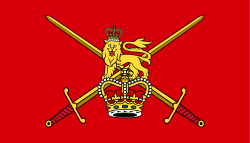 |
| British Army lists |
|---|
| French Revolutionary and Napoleonic Wars |
| Victorian era |
| First World War |
| Second World War |
| Regiments |
| Officers |
| Other |
The Army Cadet Force (ACF) is a cadet organisation based in the United Kingdom. It is a voluntary youth group sponsored by the Ministry of Defence (British Army). Local units of the ACF, called Detachments, are based in towns and villages across the UK and formed of those cadets and Cadet Force Adult Volunteers (CFAVs) parading together at that location.
Contents
- 38th (Irish) Brigade
- 1st (Northern Ireland) Battalion, Army Cadet Force
- 2nd (Northern Ireland) Battalion, Army Cadet Force
- 51st Infantry Brigade and Headquarters Scotland
- 1st Battalion The Highlanders ACF
- 2nd Battalion The Highlanders ACF
- Angus and Dundee Battalion ACF
- Argyll and Sutherland Highlanders Battalion ACF
- Black Watch Battalion ACF
- Glasgow and Lanarkshire Battalion ACF
- Lothian and Borders Battalion ACF
- West Lowland Battalion ACF
- 160th (Welsh) Brigade
- Clwyd and Gwynedd ACF
- Dyfed and Glamorgan ACF
- Gwent and Powys ACF
- Headquarters Centre
- HQ Centre (East)
- Bedfordshire and Hertfordshire ACF
- Cambridgeshire ACF
- Derbyshire ACF (Mercian Regiment)
- Essex ACF
- Leicestershire, Northamptonshire and Rutland ACF
- Lincolnshire ACF
- Norfolk ACF
- Nottinghamshire ACF
- Suffolk ACF
- HQ Centre (West)
- Hereford and Worcester ACF
- Shropshire ACF
- Staffordshire and West Midlands (North Sector) ACF
- Warwickshire and West Midlands (South Sector) ACF
- London District
- City of London and North East Sector ACF
- Greater London South East Sector ACF
- Greater London South West Sector ACF
- Middlesex and North West London Sector ACF
- Headquarters North East
- Cleveland ACF
- Durham ACF
- Humberside & South Yorkshire ACF
- Northumbria ACF
- Yorkshire (North & West) ACF
- Headquarters North West
- Cheshire & The Isle of Man ACF
- Cumbria ACF
- Greater Manchester ACF
- Lancashire ACF
- Merseyside ACF
- Headquarters South East
- Buckinghamshire (The Rifles) ACF
- Hampshire and Isle of Wight ACF
- Kent ACF
- Oxfordshire (The Rifles) Bn ACF
- Royal County of Berkshire ACF
- Surrey (PWRR Bn) ACF
- Sussex ACF
- Headquarters South West
- The Bristol and Channel Islands ACF
- References
Detachments are grouped into Areas, which may also be termed Company, Squadron, Battery or Group; which are grouped into Counties, also known as Sectors or Battalions. ACF Counties may encompass one or more geographical counties. Counties are commanded by British Army Regional Points of Command (RPOCs), which report to Regional Command. Each RPOC has a Cadets Branch, responsible for policy and administrative support, and Cadet Training Team, formed of Full-time Reservists and CFAVs who provide support and senior cadet training. [1]
Detachments may be numbered, named for the locality in which it resides, named in accordance with specific regimental or historical links, or a combination of those. Each detachment, and in some cases entire Areas and Counties, will be affiliated with a Regiment or Corps of the British Army, and wear their insignia including cap badge, beret and stable belt.
The following list is broken down into RPOCs, Counties, Areas and Detachment localities.